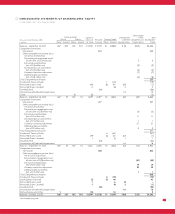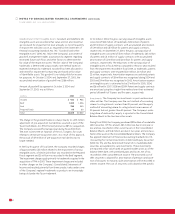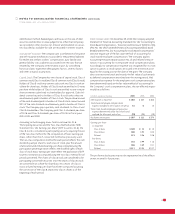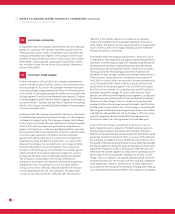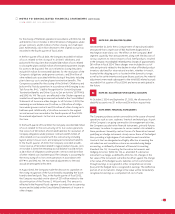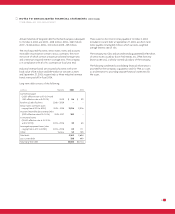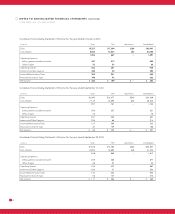Tyson Foods 2004 Annual Report Download - page 38
Download and view the complete annual report
Please find page 38 of the 2004 Tyson Foods annual report below. You can navigate through the pages in the report by either clicking on the pages listed below, or by using the keyword search tool below to find specific information within the annual report.
36
NOTES TO CONSOLIDATED FINANCIAL STATEMENTS (CONTINUED)
The Company is a purchaser of certain
commodities, such as corn, soybeans, livestock and natural gas in
the course of normal operations. The Company uses derivative
financial instruments to reduce its exposure to various market risks.
Generally, contract terms of a hedge instrument closely mirror those
of the hedged item, providing a high degree of risk reduction and
correlation. Contracts that are designated and highly effective at
meeting the risk reduction and correlation criteria are recorded using
hedge accounting, as defined by Statement of Financial Accounting
Standards No. 133, “Accounting for Derivative Instruments and Hedging
Activities” (SFAS No. 133), as amended. If a derivative instrument is
a hedge, as defined by SFAS No. 133, depending on the nature of the
hedge, changes in the fair value of the instrument will either be offset
against the change in fair value of the hedged assets, liabilities or firm
commitments through earnings or recognized in other comprehen-
sive income (loss) until the hedged item is recognized in earnings.
The ineffective portion of an instrument’s change in fair value will
be immediately recognized in earnings as a component of cost of
sales. Instruments the Company holds as part of its risk manage-
ment activities that do not meet the criteria for hedge accounting,
as defined by SFAS No. 133, as amended, are marked to fair value
with unrealized gains or losses reported currently in earnings. The
Company generally does not hedge anticipated transactions
beyond 12 months.
The Company recognizes revenue when title
and risk of loss are transferred to customers, which is generally upon
delivery based upon terms of sale. Revenue is recognized as the net
amount estimated to be received after deducting estimated amounts
for discounts, trade allowances and product terms.
There are a variety of legal proceedings pending
or threatened against the Company. Accruals are recorded when it
is probable that a liability has been incurred and the amount of the
liability can be reasonably estimated based on current law, progress
of each case, opinions and views of legal counsel and other advisers,
the Company’s experience in similar matters and management’s
intended response to the litigation. These amounts, which are not
discounted and are exclusive of claims against third parties, are
adjusted periodically as assessment efforts progress or additional
information becomes available. The Company expenses amounts
for administering or litigating claims as incurred. Accruals for legal
proceedings are included in other current liabilities in the accom-
panying balance sheets.
Freight expense associated with products shipped
to customers is recognized in cost of products sold.
Advertising and promotion
expenses are charged to operations in the period incurred. Advertising
and promotion expenses for fiscal 2004, 2003 and 2002 were
$465 million, $504 million and $396 million, respectively.
The consolidated financial statements are prepared
in conformity with accounting principles generally accepted in the
United States, which require management to make estimates and
assumptions that affect the amounts reported in the consolidated
financial statements and accompanying notes. Actual results could
differ from those estimates.
In
December 2004, the FASB issued Statement of Financial Accounting
Standards No. 151, “Inventory Costs” (SFAS No. 151). SFAS No. 151
requires abnormal amounts of inventory costs related to idle facility,
freight handling and wasted material expenses to be recognized
as current period charges. Additionally, SFAS No. 151 requires that
allocation of fixed production overheads to the costs of conversion
be based on the normal capacity of the production facilities.
The standard is effective for fiscal years beginning after June 15,
2005. The Company believes the adoption of SFAS No. 151 will not
have a material impact on its consolidated financial statements.
On October 22, 2004, the President signed into law the American
Jobs Creation Act of 2004 (the Bill). The Company is currently in
the process of evaluating the Bill.
In March 2004, the Emerging Issues Task Force (EITF) reached a
consensus on Issue No. 03-6, “Participating Securities and the
Two-Class Method under FASB Statement No. 128, Earnings per Share.”
This issue involves the computation of earnings per share for
companies that have multiple classes of common stock or have issued
securities other than common stock that participate in dividends
with common stock (participating securities). The EITF concluded
that companies having participating securities are required to apply
the two-class method to compute earnings per share. The two-class
method is an earnings allocation method under which earnings per
share is calculated for each class of common stock and participating
security considering both dividends declared (or accumulated) and
participation rights in undistributed earnings as if all such earnings
had been distributed during the period. The Company adopted
EITF Issue No. 03-6 in the fourth quarter of fiscal 2004. As required
by EITF Issue No. 03-6, prior period earnings per share have been
restated as follows:
2003 2002
Earnings per share as previously reported
Basic $0.98 $1.10
Diluted 0.96 1.08
Earnings per share, restated in accordance
with EITF Issue No. 03-6
Class A Basic 1.00 1.13
Class B Basic 0.90 1.02
Diluted 0.96 1.08







